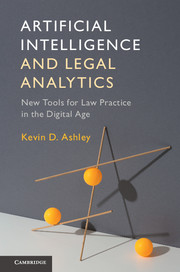Book contents
- Frontmatter
- Dedication
- Contents
- List of illustrations
- List of tables
- Acknowledgments
- PART I COMPUTATIONAL MODELS OF LEGAL REASONING
- PART II LEGAL TEXT ANALYTICS
- PART III CONNECTING COMPUTATIONAL REASONING MODELS AND LEGAL TEXTS
- 11 Conceptual Legal Information Retrieval for Cognitive Computing
- 12 Cognitive Computing Legal Apps
- Glossary
- Bibliography
- Index
11 - Conceptual Legal Information Retrieval for Cognitive Computing
from PART III - CONNECTING COMPUTATIONAL REASONING MODELS AND LEGAL TEXTS
Published online by Cambridge University Press: 13 July 2017
- Frontmatter
- Dedication
- Contents
- List of illustrations
- List of tables
- Acknowledgments
- PART I COMPUTATIONAL MODELS OF LEGAL REASONING
- PART II LEGAL TEXT ANALYTICS
- PART III CONNECTING COMPUTATIONAL REASONING MODELS AND LEGAL TEXTS
- 11 Conceptual Legal Information Retrieval for Cognitive Computing
- 12 Cognitive Computing Legal Apps
- Glossary
- Bibliography
- Index
Summary
INTRODUCTION
The LUIMA architecture, described in this chapter, takes Part II's techniques for automating conceptual markup of documents and for extracting information from legal case texts and integrates them into a prototype system for conceptual legal information retrieval. The system comprises modules for automatic subsentence level annotation, ML-based sentence annotation, basic retrieval using a full-text information retrieval system, and a ML-based reranking of the retrieved documents. The chapter explains how to evaluate such a system objectively and how to assess any contribution it makes to the full-text legal information system.
In particular, the chapter presents evidence supporting the LUIMA hypothesis, set forth in Section 10.5, that AR is feasible. By semantically annotating documents with argument role information and retrieving them based on the annotations, one can outperform current systems that rely on text matching and current techniques for legal information retrieval (Grabmair et al., 2015).
For example, as introduced in Section 6.8 and elaborated here in more detail, an attorney seeking cases on whether hepatitis B vaccine can cause multiple sclerosis or MS, may have two different questions in mind. He may want to know what the relevant legal rule is, as in (Q1) “What is the rule for establishing causation between a vaccine and an injury?” Alternatively, the attorney may seek cases applying the rule given particular facts, as in (Q2) “Have there been cases where it was held that hepatitis B vaccine can cause MS?” Depending on the user's reason underlying the query, different cases would be more responsive. For instance, consider the following sentences from the Werderitsh decision:
S1: In Althen, the Federal Circuit quoted its opinion in Grant v. Secretary of HHS, 956 F. 2d 1144, 1148 (Fed. Cir. 1992): A persuasive medical theory is demonstrated by “proof of a logical sequence of cause and effect showing that the vaccination was the reason for the injury[,]” the logical sequence being supported by “reputable medical or scientific explanation[,]” i.e., “evidence in the form of scientific studies or expert medical testimony[.]”
S2: “The undersigned holds that hepatitis B vaccine caused or significantly aggravated petitioner's MS.”
- Type
- Chapter
- Information
- Artificial Intelligence and Legal AnalyticsNew Tools for Law Practice in the Digital Age, pp. 313 - 349Publisher: Cambridge University PressPrint publication year: 2017

